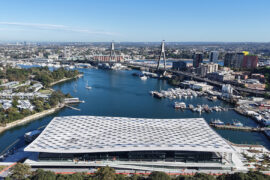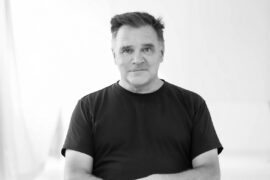In this comment piece, Mike Day, partner at Hatch, draws on his three decades as an urban design leader to offer insights into how Australian cities could become fit for the future.

January 11th, 2024
While most of us are thinking about our wish list for 2024, mine is long range. As an urban planning leader, I have a vision for the next 30 years about how Australian cities can be ‘future ready’ – and it’s not just ‘blue sky’ thinking, because I draw on my three decades as an urbanist and futurist. I’m someone who’s humbled to have had a ringside seat – and hopefully at times some influence – for the transformation of our cities.
Infrastructure is the physical and functional backbone of any city. But it’s people who bring them to life.
Cities of the future
Just how many people are we talking about? The Australian Bureau of Statistics projects that between now and 2054, our population could increase from 27.3 million to 42.7 million if the current growth rate continues. That rise is like adding the population of another Melbourne, Sydney, Brisbane and Perth combined. Now, seven out of 10 of us live in the major cities; in 30 years’ time, it’s anyone’s guess how many will be urban dwellers.
Let me wade into what city life will look and feel like – what exactly are ‘future ready’ cities?
They proactively adapt to upcoming challenges and opportunities. These cities embrace social, cultural, economic and technological change. This approach is how our urban areas can become and remain resilient and vibrant.
Tall order, maybe? To be clear, I’m not thinking singularly about boosting population densities with high-rise living, although that could be part of the picture.
Reviving urban centres
The priority is urban regeneration. That involves a concerted effort to revitalise existing urban zones, and promote sustainable development. Cities will find innovative ways of repurposing under used or obsolete urban assets. Key stakeholders will brainstorm, test and tweak ways to transform them into sustainable and functional spaces to cut waste and environmental impact. Suburban areas are part of this regeneration vision, too: they’ll become more integrated with urban centres.
It means laying the foundations for transit-based, mixed-use, walkable and accessible urban settings within the growth areas of our capital and regional cities. The result is more vibrant and eco-friendly cities.
My idea of future cities acknowledges people want to live close to the services they need, but are happy to use public transport to move beyond their neighbourhoods when they wish or need. Essentially, neighbourhoods would develop around efficient public transport rather than plan, design and operate public transit as primarily a people-moving system.
Neighbourhood hubs are a sensible way to reduce dependence on personal vehicles and therefore congestion, improving quality of life. Social value and urban prosperity will also take centre stage. The emphasis will be on enhancing long-term sustainable social wellbeing as well as inclusivity.
Related: Q&A on Buildings Breakthrough at COP28

Building on best practice and smart practice
The future will build on the success of urban renewal projects. My urban solutions team at Hatch has enthusiastically worked in the urban renewal space. We led the visioning and master-planning of an urban renewal site in Melbourne’s Burwood, just 12km from the CBD. This brownfields site of 20.5 hectares, formerly the Burwood Brickworks, lay vacant for two decades.
We fast-tracked an interactive public consultation process in just four months to come up with a comprehensive planning scheme amendment for the site. We drew on best practices – a range of Frasers Property’s (former Australand) medium-density housing types within a network of local streets, recreational corridors and open spaces. It was important to seamlessly integrate innovative housing models within the constraints of the existing topography and established streetscapes.
Creating new routes – cycle and pedestrian pathways – to local destinations allows nearby communities access to the renewed urban areas. That’s walkability and accessibility in action. Our approach was also highly commended by an expert panel assessing the local government authority’s application for Green Star Accreditation.
For us, it’s about championing integrated, mixed-use, accessible and walkable neighbourhoods that incorporate transit and green spaces.
How urban planning has changed
Since I helped found RobertsDay in 1993 (we integrated with Hatch in 2020), I’ve seen several key shifts in urban planning in Australia.
Rapid house price rises and population growth over the past three decades have transformed urban landscapes. Household sizes are smaller and that’s influenced housing preferences. We’ve also seen an apartment boom and more compact housing to increase housing affordability.
The planning and urban development sector is going full circle to again embrace transit-based, mixed-use, accessible urbanism that highlights community living and fosters social interaction.
The rise and growth of the sharing economy, such as Uber, has fundamentally disrupted transport as a service and how we navigate urban spaces. Integrating technology also shifts our understanding of transportation. Micromobility options such as e-bikes, e-scooters, even flat-packed micro electric vehicles (such as Sweden’s Luvly) help us rethink how we can get around for our daily life. This tech is just one element of the evolving concept of smart cities that integrates digital connectivity, even digital twins, with physical infrastructure and multiple travel modes – private, public and shared.
I invite you to view some of our projects that demonstrate our philosophy. Hatch has also been awarded some of Australia’s biggest projects, including the WA Government’s Future of Fremantle project, the NSW Government’s Western Sydney Bradfield development, and Victoria’s Avalon aerotropolis project.
Hatch
hatch.com
We think you might like this article covering the visit of Lacaton & Vassal to Sydney.
INDESIGN is on instagram
Follow @indesignlive
A searchable and comprehensive guide for specifying leading products and their suppliers
Keep up to date with the latest and greatest from our industry BFF's!

For Aidan Mawhinney, the secret ingredient to Living Edge’s success “comes down to people, product and place.” As the brand celebrates a significant 25-year milestone, it’s that commitment to authentic, sustainable design – and the people behind it all – that continues to anchor its legacy.
The new range features slabs with warm, earthy palettes that lend a sense of organic luxury to every space.

A curated exhibition in Frederiksstaden captures the spirit of Australian design

London-based design duo Raw Edges have joined forces with Established & Sons and Tongue & Groove to introduce Wall to Wall – a hand-stained, “living collection” that transforms parquet flooring into a canvas of colour, pattern, and possibility.

Several design groups are coming together on 29th October, 2025 for ‘grounded,’ a day of talks and workshops on Country-centred design.

In Auckland, Wingates designs a new headquarters for a specialist investment firm focused on future growth, biophilia and collaborative work.

With a date now set for January 2026, Sydney’s landmark project is taking shape as a significant and welcome addition to civic life in the city.
The internet never sleeps! Here's the stuff you might have missed

Adam Markowitz Design, in collaboration with Simeon Dux, has been awarded The Object at the INDE.Awards 2025. Their winning project, A Cabinet of Curiosities, is a masterwork of craftsmanship and adaptability; a poetic response to shifting domestic and professional life in the post-COVID era.

In this comment piece, COX Principal David Holm reflects on Carlo Ratti’s curatorship in which climate, colonisation and gender equity took centre stage at the Venice Biennale.